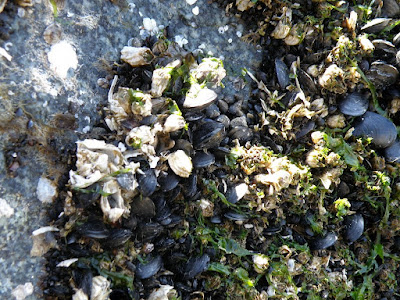So why, in over a dozen photos of mussels and barnacles on that same beach, can I find only one lonely whelk?
Nestled in among the mussels, I find periwinkles and black turbans. They are vegetarian, algae eaters. So are the limpets around the edges of the mussel beds. But where are the whelks?
I went back to my Pacific Seashores book for an answer. In the chapter on the causes of intertidal zonation, I found a few clues. It may have to do with the distance from the high tide line. Mussels, barnacles, and periwinkles tolerate being out of the water for longer periods than do whelks. They can close themselves down tightly against heat and dry air. Not whelks.
Wikipedia says, of the dog whelk (Atlantic),
The dog whelk can only survive out of water for a limited period, as it will gradually become desiccated and die if emersed (out of water) for too long. Metabolic processes within cells take place in solution, and a decrease in water content makes it impossible for the organism to function properly. ... Furthermore, the dog whelk has to excrete ammonia directly into water, as it does not have the adaptation possessed by many upper shore species which would allow it to produce uric acid for excretion without loss of water. When kept emersed for seven days at a temperature of 18°C, 100% of dog whelks die, in contrast to many periwinkle species which can lose even more water than the dog whelk (i.e. more than 37% of their total body mass) but survive as a result of their ability to excrete toxic waste products more efficiently.Another factor, mentioned in the book, is the time involved. A whelk fastens itself to its chosen mussel, then drills through the shell to reach the meat. On a large mussel, meal preparation and eating may take up to 60 hours. But in the upper intertidal zone, much of this time is, of necessity, out of water. (Barnacles take less time, because the proboscis is inserted between the valves, instead of in a hole that has to be manufactured.)
So I come to the conclusion that the tide was higher this last Wednesday than the previous two times we visited the same spot. Since each time we were examining the life at the very edge of the water, we found the species most suited to that level. I think I may have to start measuring, pacing the distance out, to see where the individual habitats begin and end.
I examined all the photos, at twice full size, several times. At last, I found a whelk. One only.
.






I'm still looking! I'm sure it's right under my nose.
ReplyDeleteDarn...wheres whelko?
ReplyDeleteHe's right there!
ReplyDeleteOk, I'll help; see next post.